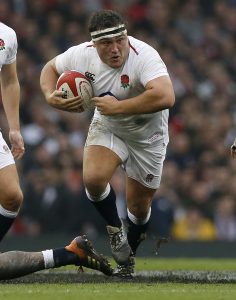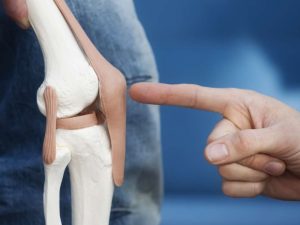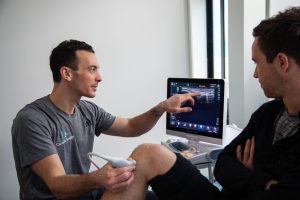5th December 23
Understanding Knee Injuries in Rugby
Introduction
Rugby, like other contact sports, is physically demanding and puts strain on the body. It requires explosive power, agility, and stamina. Players engage in high-intensity activities such as sprinting, jumping, tackling, and running, which can lead to injuries.
The combination of physical contact and dynamic movement patterns increases the risk of knee injuries, ranging from minor sprains to torn ligaments and dislocated kneecaps.
Importance of Understanding Common Injuries in Rugby
Understanding common injuries in rugby, particularly knee injuries, is crucial for several
reasons.
Firstly, it improves preventative measures – if players, coaches and medical professionals are aware of the risks, they can implement strategies to mitigate them. This can include specific training programs to strengthen key muscle groups, correct tackling techniques, or protective gear.
Secondly, a comprehensive understanding helps in the early detection and efficient treatment of injuries. By recognizing the signs and symptoms of common injuries, immediate intervention can be administered, reducing long-term consequences and improving recovery timeframes.
Lastly, education about injuries can foster a culture of safety within the sport, promoting responsible play and respect for one’s own physical condition and that of fellow players.
Common Types of Knee Injuries in Rugby
Knee injuries in rugby can be broadly categorized into several types, each differing in their severity and implications. Some of the most common knee injuries suffered by rugby players include:
1. Ligament Tears: The knee comprises four main ligaments, each susceptible to injury during rigorous physical activity. The Anterior Cruciate Ligament (ACL) and Medial Collateral Ligament (MCL) are particularly vulnerable in rugby due to the high-intensity, multidirectional movements.
2. Meniscus Injuries: The meniscus is a cartilage disc that cushions the knee. Sudden twisting motions, often seen when evading tackles or changing direction rapidly, can lead to meniscal tears.
3. Patellar Subluxation: This injury involves the temporary dislocation of the kneecap (patella), which usually occurs when the knee is hit directly, a common occurrence in rugby tackles.
4. Knee Tendon Injuries: Overuse or strain can lead to injuries in the Patellar and Quadriceps tendons, which connect the knee cap to the surrounding muscles.
Prompt recognition and treatment of these injuries can significantly affect a player’s recovery and future performance. Therefore, it is crucial for anyone involved in the sport to be knowledgeable about these common knee injuries.
Anatomy of the Knee and Impact of Rugby
The knee is a complex joint where the femur (thigh bone), tibia (shin bone), and patella (kneecap) converge. The knee also houses two important cartilaginous structures: the medial and lateral menisci that serve as shock absorbers and load distributors.
Four primary ligaments ensure stability in the knee: the Anterior Cruciate Ligament (ACL), Posterior Cruciate Ligament (PCL), Medial Collateral Ligament (MCL), and Lateral Collateral Ligament (LCL).
The Quadriceps and Patellar tendons are also key structures, connecting muscle to bone and enabling knee extension.
Rugby exerts significant impact on the knee due to the explosive power, agility, and stamina needed for the game. Tackling and contact phases can place direct force on the knee, potentially causing dislocations, ligament tears, or fractures. Rapid changes in direction, which
are integral to rugby, place additional stress on the ligaments and menisci.
Over time, repeated strain can result in overuse injuries to the tendons, such as tendinitis. Understanding the intricate anatomy of the knee and how rugby impacts it is fundamental for injury prevention and treatment in the sport.
Causes of Knee Injuries in Rugby
Knee injuries in rugby can be attributed to a variety of factors, which often involve aspects of
training, technique, and equipment.
1. Improper Technique: A significant cause of knee injuries is improper technique during play. This can involve incorrect tackling or landing methods, or poor running form. The wrong technique not only compromises performance but also places undue stress on the
knee, increasing the risk of injury.
2. Inadequate Training: Inadequate or improper training can also lead to knee injuries. Insufficient strength and conditioning, particularly of the leg muscles, can result in instability and increased vulnerability to injury. In addition, inadequate warm-up or
cool-down exercises, or a lack of flexibility training can contribute to the risk of knee injuries.
3. Lack of Protective Gear: Lastly, the lack of proper protective gear can also contribute to knee injuries in rugby. Knee pads, for instance, can help absorb some of the impact during a tackle or fall, reducing the risk of serious injury.
These causes are not exhaustive and multiple factors can often interact, leading to an increased likelihood of knee injuries. Therefore, it is crucial to address these aspects in a comprehensive injury prevention strategy in rugby.

©Matthew Impey / Wired Photos
Picture by Matt Impey +44 7789 130347
Prevention of Knee Injuries in Rugby
Prevention of knee injuries in rugby is best achieved through a multi-faceted approach. One of the most important aspects of this approach is the implementation of proper warm-ups and cool-downs.
Warm-ups prior to training or a match prepare the body for physical exertion and can significantly reduce the risk of knee injuries. A good warm-up raises body temperature, increases blood flow to the muscles, and enhances joint flexibility, leading to improved
performance and reduced injury risk.
Cool-downs post-exercise are equally crucial. They help in gradually lowering the heart rate and preventing blood from pooling in the muscles. Furthermore, cool-down exercises involving stretching can aid in the removal of lactic acid, reducing muscle soreness and speeding up recovery.
A comprehensive warm-up might include light cardio activities, dynamic stretches, and sport-specific movements. Cool-downs, on the other hand, tend to focus on slow, static stretching and relaxation techniques. Implementing these practices consistently can contribute
substantially to knee injury prevention in rugby.
Role of Proper Training and Technique in Preventing Injuries
Proper training and technique bear significant influence on injury prevention in rugby, particularly concerning the knee. Technique plays a pivotal role in almost every movement in rugby, from running and jumping to tackling and landing.
For instance, understanding and executing the correct technique for tackling can significantly reduce the direct impact on the knees, while proper landing technique can mitigate the risk of an awkward fall leading to sports injuries.
Training, on the other hand, equips the body to withstand the physical demands of the sport. Strength and conditioning exercises can fortify the muscles supporting the knee, improving stability and resilience. Focused training can also enhance agility, speed, and power, further fortifying the body against potential injuries.
Moreover, training should also encompass elements of balance and flexibility, both of which can significantly influence knee health. Balance exercises can improve proprioception, enabling better body control and reducing the likelihood of missteps leading to injury. Flexibility exercises, on the other hand, can enhance the range of motion and prevent potential strain injuries.
Treatment and Recovery
Professional medical intervention is necessary when dealing with serious knee injuries. It’s often required to accurately diagnose the extent of the injury and prescribe an appropriate treatment plan. The type of treatment depends on the severity and type of injury.
For ligament tears, such as ACL, PCL, MCL, or LCL tears, surgery might be necessary, especially if the athlete aims to return to a high level of activity.
Meniscal tears might also require surgical intervention, depending on the location and extent of the tear.
Beyond surgery, physiotherapy is a key component of the recovery process. It helps restore strength, flexibility, and range of motion in the injured knee. Physiotherapy typically includes exercises that target muscle strength, balance, and flexibility, all of which contribute to knee stability and function.
In some cases, particularly with overuse injuries, rest and conservative management might be sufficient. It’s important to remember that every injury is unique, and the treatment and recovery process should be tailored to the individual athlete under professional medical guidance.
Role of Physiotherapy in Recovery
Physiotherapy plays a pivotal role in the recovery process from knee injuries in rugby. It is a rehabilitative approach aimed at restoring function and movement in individuals affected by injury, illness, or disability.
For rugby players recovering from knee injuries, physiotherapy can be instrumental in helping them regain their pre-injury level of activity and minimizing the chances of re-injury.
Physiotherapists employ a variety of methods to help facilitate recovery. These can include range of motion exercises, strengthening exercises, manual therapy techniques, balance and coordination activities, and sport-specific activities. They may also use modalities like heat, ice, electrical stimulation, and shockwave to help control pain and inflammation, and to promote healing.
In sport-specific activities, physiotherapists guide players through exercises that mimic the movements they will perform in rugby, gradually increasing intensity to reflect game conditions. This helps to prepare players for their return to the sport, ensuring they are physically ready and confident in their ability to play.
Rest and proper rehabilitation are essential components in the journey of recovering from knee injuries in rugby. Adequate rest allows the body to repair damaged tissues, reduce inflammation, and restore strength, all of which are critical for the healing process.
Conclusion
In conclusion, understanding, preventing, and treating knee injuries in rugby are crucial for athlete health and performance. Proper technique and training play a fundamental role in injury prevention. Emphasizing strength, balance, and flexibility in training can greatly reduce injury risk.
Professional medical intervention is essential for injury management, ranging from surgery to physiotherapy. Physiotherapy aids in recovery, restoring strength, flexibility, and range of motion. By integrating preventive measures, prompt treatment, and comprehensive
rehabilitation, the prognosis for rugby players with knee injuries can significantly improve, allowing them to return to sport confidently.





